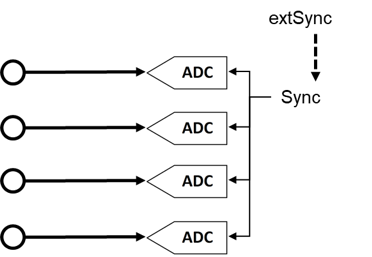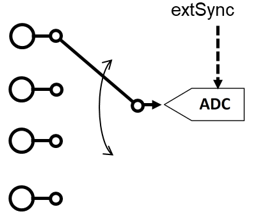Sampling type: Simultaneous vs. multiplexed
Analog inputs and outputs in Beckhoff devices can operate in 2 different ways in terms of time: "simultaneous sampling" or "multiplex sampling". This so-called sampling type has a decisive influence on the performance of such a device and must be taken into consideration when selecting a product, at least when it comes to very complex timing control tasks. Whether an analog device operates simultaneously or multiplexed can be taken from the respective device documentation.
This question is relevant for control tasks as well as for measurement tasks (DataRecording), if the timing of the analog value acquisition is sensitive.
Note: The terms "simultaneous" and "multiplex" have been used for a long time and in many contexts, so they have different meanings depending on the historical background and the subject area. In this chapter and in relation to I/O, the terms are used as Beckhoff understands them as an I/O manufacturer for the benefit of the user:
- If a test signal is applied electrically to all channels of a multi-channel device at the same time and the measurements are evaluated in software, e.g. in TwinCAT Scope, and if no significant offset/delay can be observed between the channels, then it is a simultaneously sampling device *)
- If an offset can be seen, it is a multiplex sampling device
- The easiest test to perform is with a square wave signal because an offset can then be easily observed. However, the rare special case could occur (especially if the test signal is generated from an EL2xxx/EL4xxx from the same IO line) that the square wave signal runs synchronously to the EtherCAT for several minutes and then no offset can be seen.
Absolutely safe is a test with a sinusoidal signal, but then it must be considered that measurement deviations (related to the amplitude) of the channels in the device are also represented as time offset!
Ideally, one should concentrate on the zero crossing.
- 1-channel devices are considered as simultaneous sampling by definition.
Explanation with the example "analog input": if a continuous analog signal is to be digitized and thus fed to the further programmatic processing, it is digitized by a so-called ADC (AnalogDigitalConverter), e.g. with 16 bit resolution:

This represents an analog input channel that is functional in itself. It samples (measures) as often as desired, e.g. 1,000 times per second, and thus sends 1,000 measured values equidistant in time (= at equal time intervals) for further processing.
Often several channels are combined in one device, in this case the question arises about the sampling type: simultaneous or multiplex.
*) For experts: such a device could also be equipped with a multiplexing ADC, which works with sample-and-hold on all channels. Then technically multiplex is built in, but from the outside the device works simultaneously, because all channels are electrically read in at the same time.
Simultaneous
As in the 1-channel example, each channel can have its own ADC, shown here for 4 channels:

These ADCs rarely run free in time and sample independently but are normal triggered in some way (the measurement is triggered) to achieve the most desired effect that the n channels sample simultaneously. This gives the analog input device the property that all (4) measurements are obtained at the same time. This gives a temporally consistent view of the machine situation and makes measurement evaluations in the controller very easy. If the ADC are triggered simultaneously by the sync signal, this is called simultaneous sampling.
A special added value arises when such devices are synchronized externally, e.g. via EtherCAT DistributedClocks, and then all analog channels of all devices of a plant operate simultaneously: either really simultaneously without offset among each other or with the same frequency but with constant, known and thus compensatable offset among each other.
As shown above, this requires extensive electronics with multiple identical structures. For this reason, parallel analog devices are usually always simultaneously sampling. Free-running or non-triggered, multiple ADCs are conceivable (and can then no longer be called "simultaneous"), but are rather uncommon.
Multiplex
Simultaneous sampling is often not required for simple automation tasks. This may be because the simplest analog electronics are to be used for cost reasons, or the control cycle time is relatively slow compared to the conversion time in the ADC. Then the advantages of the multiplex concept can be used: Instead of 4 ADC only one ADC is installed, for this a channel switch (from the device manufacturer) must be installed, which switches through the 4 input channels to the ADC quickly one after the other in the µs range. The switching process is performed by the device itself and is usually not accessible from the outside.

This is therefore a time multiplex. As a rule the ADC samples equally clocked, the time intervals of the channels are therefore equal, whereby the start of channel 1 is usually done by the communication cycle (EtherCAT) or DistributedClocks. For further details please refer to the device documentation.
Advantage: cheaper electronics compared to simultaneous setup.
Disadvantage: the measured values are no longer acquired simultaneously, but one after the other.
Both circuits have their technical and economic justification, for time demanding automation tasks simultaneous circuits should always be chosen, because with them it is easier to keep the temporal overview.
For analog outputs the same explanations apply, they can also be equipped with multiple simultaneous DACs or output a multiplexed DAC to several outputs.